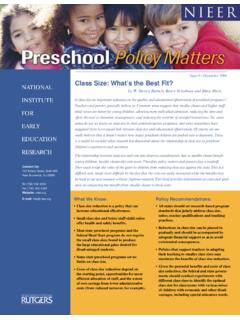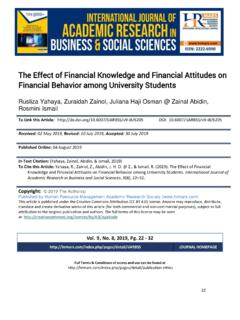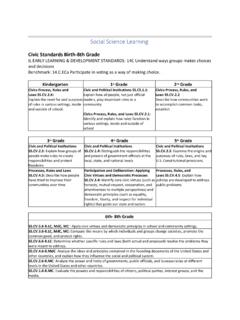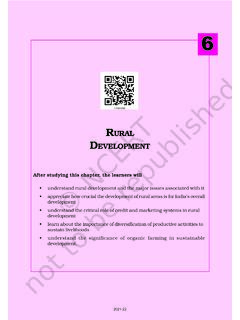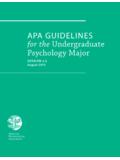Transcription of Family Engagement: An Integrated Review of the Literature
1 Family Engagement, Diverse Families, and Early Childhood Education Programs: An Integrated Review of the Literature Linda C. Halgunseth and Amy Peterson National Association for the Education of Young Children Deborah R. Stark and Shannon Moodie Pre-K Now Acknowledgements: The National Association for the Education of Young Children and Pre-K Now would like to extend their gratitude to all who reviewed and provided feedback on an earlier draft of this paper, especially the Advisory Committee on Family Engagement in Early Learning (Nikki Aikens, Rose Anello, Samtra Devard, Rosemary Fennell, Sue Ferguson, Amie Lapp Payne, Barbara Littledave, Beverly Raimondo, Holly Robinson, Wilma Robles de Melendez, Lori Roggman, Marta Rosa, Fran Simon, Heather Weiss, and Jane Zamudio). This project was funded by the generous support of The Picower Foundation. 2009 2 Table of Contents Section A: Integrated Literature 3-15 Figure 8 Section B: Conclusion and Draft 16-17 Section C: 18-23 2009 3 Integrated Literature Review Introduction A growing body of research suggests that meaningful engagement of families in their children s early learning supports school readiness and later academic success (Henrich & Gadaire, 2008; Weiss, Caspe, & Lopez, 2006).
2 Family engagement is often considered in union with children s participation in early childhood education programs. High rates of program enrollment among young children across several ethnic groups may be a possible reason for this trend. In 2005, 60 percent of children under age 6 spent some time in nonparental care arrangements: 62 percent of white children, 69 percent of black children, and 49 percent of Hispanic children were in such programs (Iruka & Carver, 2006). As a means to supporting Family engagement and children s learning, it is crucial that programs implement strategies for developing partnerships with families (Henderson & Mapp, 2002). These strategies should be appropriate for the diverse population programs serve and reflect a commitment to outreach (Colombo, 2006; Crawford & Zygouris-Coe, 2006). To address these issues, we will Review the Literature on Family engagement that pertains to all young children across ethnic backgrounds and early childhood education programs.
3 Definition of Family Engagement This Review conceptualizes Family engagement as essential for enhancing children s learning and Family well being. Family engagement occurs when there is an on-going, reciprocal, strengths-based partnership between families and their children s early childhood education programs. From the Literature and a synthesis of three definitions of Family engagement, Henderson and Berla (1994), Epstein (2001), and Weiss et al. (2006), we have created a comprehensive definition of Family engagement that features six factors: 1. Early childhood education programs encourage and validate Family participation in decision making related to their children s education. Families should act as advocates for their children and early childhood education program by actively taking part in decision making opportunities. 2. Consistent, two-way communication is facilitated through multiple forms and is responsive to the linguistic preference of the Family . Communication should be both school and Family initiated and should be timely and continuous, inviting conversations about both the child s educational experience as well as the larger program.
4 3. Families and early childhood education programs collaborate and exchange knowledge. Family members share their unique knowledge and skills through volunteering and actively engaging in events and activities at schools. Teachers seek out information about their students lives, families, and communities and integrate this information into their curriculum and instructional practices. 4. Early childhood education programs and families place an emphasis on creating and sustaining learning activities at home and in the community that extend the teachings of the program so as to enhance each child s early learning. 2009 45. Families create a home environment that values learning and supports programs. Programs and families collaborate in establishing goals for children both at home and at school. 6. Early childhood education programs create an ongoing and comprehensive system for promoting Family engagement by ensuring that program leadership and teachers are dedicated, trained and receive the supports they need to fully engage families.
5 While the above definition is composed of six factors, to promote a comprehensive and continuous approach to Family engagement it is necessary to recognize how the factors interact and work together. It is not sufficient to focus engagement efforts on one of the components and neglect the others. Simply attending a workshop or meeting does not necessarily result in an educator or Family member changing their beliefs or actions (Ferguson, Ramos, Rudo, & Wood, 2008). Achieving a strong Family -program partnership requires a culture that supports and honors reciprocal relationships, commitment from program leadership, a vision shared by staff and families, opportunities to develop the skills needed to engage in reciprocal relationships, and practices and policies that support meaningful Family engagement. Past Models In constructing the above definition, we reviewed several past models that have conceptualized and measured Family engagement. In this section, we will present these models and will discuss the need to broaden current perspectives on Family engagement to one that focuses on strengthening the relationship between families and early childhood education programs as a means to improving child well-being.
6 Past Family engagement research has focused primarily on parent-initiated behavior and on measuring tasks that parents perform either at the program setting or with their children in the home. These tasks are often referred to as Parent Involvement and can include (1) discussing the school day with child, (2) direct and regular contact with teachers, (3) volunteering in the classroom, (4) planning or attending school activities or events, (5) actively promoting learning in the home, (7) chaperoning field trips, (8) developing fundraising activities, and (10) working in parent-teacher organizations (Carlisle, Stanley, & Kemple, 2005; Mantzicopoulos, 2003; McWayne, Hampton, Fantuzzo, Cohen, & Sekino 2004; Rous, Hallam, Grove, Robinson and Machara, 2003). While research has found positive relations between parent participation in school activities and outcomes for pre-kindergarteners and kindergartners (Mantzicopoulos, 2003; McWayne et al., 2004), some concerns have been raised regarding the traditional parent involvement paradigm, especially in regards to cultural-sensitivity.
7 Souto-Manning and Swick (2006) and Crawford and Zygouris-Coe (2006) suggest that the traditional paradigm for parent involvement focuses on the deficiencies of parents and strives to adapt parents to the methods applied by the schools. According to this definition, the responsibility for involvement is placed on the parent and suggests that to be involved parents need to participate in school defined practices such as volunteering in the classroom. In addition, programs that implement a traditional parent involvement model may also be perceived as insensitive to Family members time, financial, or educational limitations. In the case of culturally-diverse families, other practices implemented at home that support children s 2009 5education may be overlooked and underappreciated. These misperceptions of early childhood education programs may lead to a disconnect in the partnership between families and programs (Quiocho & Daoud, 2006; Wong & Hughes, 2006, Valdes, 1999). Lastly, in some cultures, multi-generational households are common, and extended Family members and fictive kin have important roles in caring for and raising children (McAdoo, 2000; Valdes, 1999).
8 Henderson and Mapp (2002, p. 10) highlight the importance of Family by recognizing that all Family members -- siblings, grandparents, aunts, uncles, and fictive kin -- who may be friends or neighbors, often contribute in significant ways to children s education and development. Traditional parental involvement models, however, do not incorporate other important Family members that are active participants in the child s development and learning. Not all models of Family engagement have focused primarily on parent-initiated practices, however. There are some models that have recognized the school s role in promoting Family engagement. For example, Epstein (2001) presents a comprehensive approach of involvement for Family and professional partnerships. The model identifies practices that schools can implement to facilitate parent involvement. It recognizes that diverse needs and expectations exist across families and educators and that what may work in the life of one child may not work for another.
9 In these instances, the model calls for families and educators to work together, to develop goals, and to establish the best possible practices that are meaningful and appropriate for both parties. The six elements to Epstein s model are: 1. Parenting = Help all families establish home environments to support children as students 2. Communicating = Design effective forms of school-to-home and home-to school communications about school programs and their children s progress 3. Volunteering = Recruit and organize parent help and support 4. Learning at Home = Provide information and ideas to families about how to help students at home with homework and other curriculum-related activities, decisions, and planning 5. Decision Making = Include parents in school decisions, developing parent leaders and representatives 6. Collaborating with Community = Identify and integrate resources and services from the community to strengthen school programs, Family practices, and student learning and development.
10 Weiss et al. (2006) also provide an integrative model of Family involvement that is evidence-based or clearly linked to positive child outcomes. Their model encompasses three important categories: Parenting, Home-School Relationships, and Responsibility for Learning Outcomes. Parenting includes the attitudes, values, and practices that parents use in raising young children. This category would include nurturing parent-child relationships and child-centered practices. Home-School Relationships pertain to both formal and informal connections between families and young children s early childhood education programs. It may include regular communication with teachers and efforts by the early childhood education programs to increase nontraditional contact between families and teachers such as home-visits or parent-discussion groups. Responsibility for Learning Outcomes speaks to how parents can support the language and literacy development of their children through direct parent-teaching activities such as reading aloud and engaging in linguistically rich conversations with their children.


